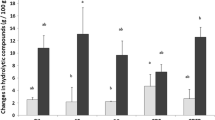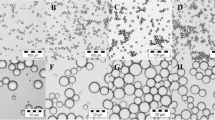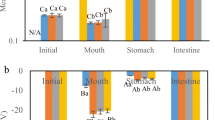Abstract
The present work was designed to prepare linseed oil (LSO) microemulsion and explore the possibility of enhancing the uptake and utilization of α-linolenic acid (ALA) present in LSO. The bioavailability of encapsulated LSO as against native oil was monitored in rats by measuring the uptake in vitro using the intestinal everted sac model and in-vivo administration of microemulsions of LSO to rats for a period of 30 days. Microemulsions were prepared by using different binding materials such as gum acacia, whey protein and lipoid. When LSO was encapsulated with gum acacia, whey protein and lipoid, the levels of ALA uptake into intestinal sacs was increased by 6, 17 and 28 % as compared to oil given without encapsulation. EPA and DHA were not observed in the oil absorbed by intestinal everted sacs when given as emulsions with gum acacia or whey protein. When LSO was given as microemulsions with lipoid, EPA + DHA was observed in oil absorbed by intestinal sacs. Similarly when LSO was given as a lipoid emulsion by intubation to rats, the EPA and DHA in serum lipids were found to be 41 and 34 μg/ml, respectively while rats given LSO without encapsulation contained EPA and DHA at 9.1 and 8.8 μg/ml, respectively. Similar changes in omega-3 fatty acid content in liver lipids were observed when LSO was given as a microemulsion with lipoid. This study indicated that ALA was taken up and metabolized to long chain omega-3 PUFA when given as microemulsion with lipoid.

Similar content being viewed by others
Abbreviations
- SNO:
-
Sunflower oil
- LSO:
-
Linseed oil
- PUFA:
-
Polyunsaturated fatty acid(s)
- LA:
-
Linoleic acid (18:2, n-6)
- ARA:
-
Arachidonic acid (20:4, n-6)
- ALA:
-
Alpha linolenic acid (18:3, n-3)
- EPA:
-
Eicosapentaenoic acid (20:5, n-3)
- DHA:
-
Docosahexaenoic acid (22:6, n-3)
References
Burdge GC, Calder PC (2005) Conversion of α-linolenic acid to longer-chain polyunsaturated fatty acids in human adults. Reprod Nutr Dev 45:581–597
Brenna JT, Salem N, Sinclair AJ, Cunnane SC (2009) α-Linolenic acid supplementation and conversion to n–3 long chain polyunsaturated fatty acids in humans. Prostag Leukot Essent Fatty Acids 41:95–99
Ramaprasad TR, Baskaran V, Sambaiah K, Lokesh BR (2010) Lower efficacy in the utilization of dietary ALA as compared to preformed EPA + DHA on long chain omega-3 PUFA levels in rats. Lipids 45:799–808
Ammar W, Grahame M, Alberto D, Gordo B, Stephen A (2010) Enhanced bioavailability of eicosapentaenoic acid from fish oil after encapsulation within plant spore exines as microcapsules. Lipids 45:645–649
Haug IJ, Sagmo LB, Zeiss D, Olsen IC, Draget IK, Seternes T (2011) Bioavailability of EPA and DHA delivered by gelled emulsions and soft gel capsules. Eur J Lipid Res 113:137–145
Cansell M, Nacka F, Combe N (2003) Marine lipid based liposome increase in vivo FA bioavailability. Lipids 38:551–559
Shaikh J, Ankola DD, Beniwal V, Singh D, Ravikumar NV (2009) Nanoparticle encapsulation improves oral bioavailability of curcumin by at least 9-fold when compared to curcumin administered with piperine as absorption enhancer. Eur J Pharm Sci 37:223–230
Duan J, Zhao Y (2011) Chitosan–whey protein isolate composite films for encapsulation and stabilization of fish oil containing ultra pure omega-3 fatty acids. J Food Sci 76:C133–C141
Gunasekaran S, Ko S, Xiao L (2007) Use of whey proteins for encapsulation and controlled delivery applications. J Food Eng 83:31–40
Subirade M, Remondetto G, Beaulieu L (2003) Whey protein derived biomaterials and their use as bioencapsulation and delivery system. Chem Ind 57:617–621
Minemoto Y, Hakamata K, Adachi S, Matsuno R (2002) Oxidation of linoleic acid encapsulated with gum arabic or maltodextrin by spray-drying. J Microencaps 19:181–189
Zou J, Saulnier P, Perrier T, Zhang Y, Manninen T, Toppila E, Pyykko I (2008) Distribution of lipid nanocapsules in different cochlear cell populations after round window membrane permeation. J Biomed Mater Res Part B: Appl Biomater 87B:10–18
Cansell M, Moussaoui N, Petit AP, Denizot A, Combe N (2006) Feeding rats with liposomes or fish oil differently affects their lipid metabolism. Eur J Lipid Sci Technol 108:459–467
Hossain Z, Kurihara H, Hosokawa M, Takahashi K (2006) Docosahexaenoic acid and eicosapentaenoic acid enriched phosphatidyl choline liposomes enhance the permeability, transportation and uptake of phospholipids in Caco-2 cells. Mol Cell Biochem 285:155–163
Carnielli V, Verlato G, Pederzini F, Luijendijk I, Boerlage A, Pedrotti D, Sauer P (1998) Intestinal absorption of long chain polyunsaturated fatty acids in preterm infants fed breast milk or formula. Am J Clin Nutr 67:97–103
McNamee BF, O’Riordan ED, O’Sullivan M (1998) Emulsification and microencapsulation properties of gum arabic. J Agric Food Chem 46:4551–4555
Jafari SM, Assadpoor E, Bhandari B, Yinghe HE (2008) Nano-Particle encapsulation of fish oil by spray drying. Food Res Int 41:172–183
Danviriyakul S, McClements DJ, Decker EA, Nawar WW, Chinachoti CP (2002) Physical stability of spray dried milk fat emulsions as affected by emulsifiers and processing conditions. J Food Sci 67:2183–2187
Rosenberg M, Kopelman IJ, Talmon Y (1985) A scanning electron microscopy study of microencapsulation. J Food Sci 50:139–144
Jafari SM, Yinghe HE, Bhandari B (2011) Role of powder particle size on the encapsulation efficiency of oils during spray drying. Drying Technol 25:1081–1089
Morrison WR, Smith LM (1963) Preparation of fatty acid methyl esters and dimethyl acetals with boron trifluoride methanol. J Lipid Res 5:600–608
Suresh D, Srinivasan K (2007) Studies on the in vitro absorption of spice principles—Curcumin, capsaicin and piperine in rat intestines. Food Chem Toxicol 45:1437–1442
Folch J, Lees M, Stanley GHS (1957) A simple method for the isolation and purification of total lipids from animal tissues. J Biol Chem 226:497–509
Kris-Etherton PM, Grieger JA, Etherton TD (2009) Dietary reference intakes for DHA and EPA. Prostagl Leukotr Essentl Fatty Acids 81:99–104
Sinclair AJ, Attar-Bashi NM, Li D (2002) What is the role of alpha-linolenic acid for mammals? Lipids 37:1113–1123
Earnest CP, Hammar MK, Munsey M, Mikus CR, David RM, Bralley JA, Church TS (2009) Microencapsulated foods as a functional delivery vehicle for omega-3 fatty acids: a pilot study. J Int Soc Sports Nutr 6:12. doi:10.1186/1550-2783-6-12
Ramaprasad TR, Baskaran V, Sambaiah K, Lokesh BR (2004) Supplementation and delivery of n–3 fatty acids through spray-dried milk reduce serum and liver lipids in rats. Lipids 39:627–632
Couedelo L, Vaysse CB, Fonseca L, Montesinos E, Djoukitch S, Combe N, Cansell M (2011) Lymphatic absorption of α-linolenic acid in rats fed flaxseed oil-based emulsion. Br J Nutr 105:1026–1035
Nishimukai M, Hara H (2007) Soybean phosphatidylcholine-induced enhancement of lymphatic absorption of triglyceride depends on chylomicron formation in rats. Biosci Biotechnol Biochem 71:1192–1197
Garaiova I, Guschina IA, Plummer SF, Tang J, Wang D, Plummer NT (2007) A randomised cross-over trial in healthy adults indicating improved absorption of omega-3 fatty acids by pre-emulsification. Nutr J 6:4. doi:10.1186/1475-2891-6-4
Chilton FH, Surette ME and Koumenis IL (2002) Fatty acid containing emulsion with increased bioavailability. US Patent 2002/0188024A1
Cansell M (2010) Marine phospholipids as dietary carriers of long chain polyunsaturated fatty acids. Lipid Technology 22:223–226
Jimenez M, Garcia HS, Beristain CI (2004) Spray-drying microencapsulation and oxidative stability of conjugated linoleic acid. Eur Food Res Technol 219:588–592
Partenen R, Raula J, Seppanen R, Buchert J, Kauppinen E, Forssell P (2008) Effect of relative humidity on oxidation of flaxseed oil in spray dried whey protein emulsions. J Agric Food Chem 56:5712–5722
Raatz SK, Redmon JB, Wimmergren N, Donadio JV, Bibus DM (2009) Enhanced absorption of n–3 fatty acids from emulsified compared with encapsulated fish oil. J Am Diet Assoc 109:1076–1081
Fricker G, Kromp T, Wendel A, Blume A, Zirkel J, Rebmann H, Setzer C, Quinkert RO, Marin F, Goymann CM (2010) Phospholipids and lipid based formulation in oral drug delivery. Pharm Res 27:1469–1486
Cuomo J, Appendino G, Dern AS, Schneider E, McKinnon TP, Brown MJ, Togni S, Dixon BM (2011) Comparative absorption of a standardized curcuminoid mixture and its lecithin formulation. J Nat Prod 74:664–669
Hu L, Jia Y, Niu F, Jia Z, Yang X, Jiao K (2012) Preparation and enhancement of oral bioavailability of curcumin using microemulsions vehicle. J Agric Food Chem. doi:10.1021/jf204078t
Luo Y, Chen D, Ren L, Zhao X, Quin J (2006) Solid lipid nanoparticles for enhancing vinpocetine’s bioavailability. J Controlled Release 114:53–59
Nornoo AO, Zheng H, Lopes LB, Restrepo BJ (2009) Oral microemulsions of paciltaxel: in situ and pharmacokinetic studies. Eur J Pharm Biopharm 71:310–317
Mailard S, Ameller T, Gauduchon J, Gougelet A, Gouilleux F, Legrand P, Marsaud V, Fattal E, Sola B, Renoir JM (2005) Innovative drug delivery nanosystems improve the anti-tumor activity in vitro and in vivo of anti-estrogens in human breast cancer and multiple myeloma. J Steroid Biochem Mol Biol 94:111–121
Vyas TK, Shahiwala A, Amiji MM (2008) Improved oral bioavailability and brain transport of saquinavir upon administration in novel nanoemulsion formulations. Int J Pharm 347:93–101
Abuasal BS, Lucas C, Peyton B, Alayoubi A, Nazzal S, Sylvester PW, Kaddoumi A (2012) Enhancement of intestinal permeability utilizing solid lipid nanoparticles increases γ-tocotrienol oral bioavailability. Lipids 47:461–469
Acknowledgments
The authors thank the Director of the Central Food Technological Research Institute for his encouragement and support. D. Sugasini acknowledges the grant of a Senior Research Fellowship by the Indian Council of Medical Research, New Delhi, India. The authors thank A.M. Raichur and S. Anandkumar from the Indian Institute of Science, Bangalore for their help in particle size analysis. The authors also thank C. Radha for help in the operation of the high pressure homogenizer.
Conflict of interest
There is no conflict of interest.
Author information
Authors and Affiliations
Corresponding author
Electronic supplementary material
Below is the link to the electronic supplementary material.
About this article
Cite this article
Sugasini, D., Lokesh, B.R. Uptake of α-Linolenic Acid and Its Conversion to Long Chain Omega-3 Fatty Acids in Rats Fed Microemulsions of Linseed Oil. Lipids 47, 1155–1167 (2012). https://doi.org/10.1007/s11745-012-3731-9
Received:
Accepted:
Published:
Issue Date:
DOI: https://doi.org/10.1007/s11745-012-3731-9




